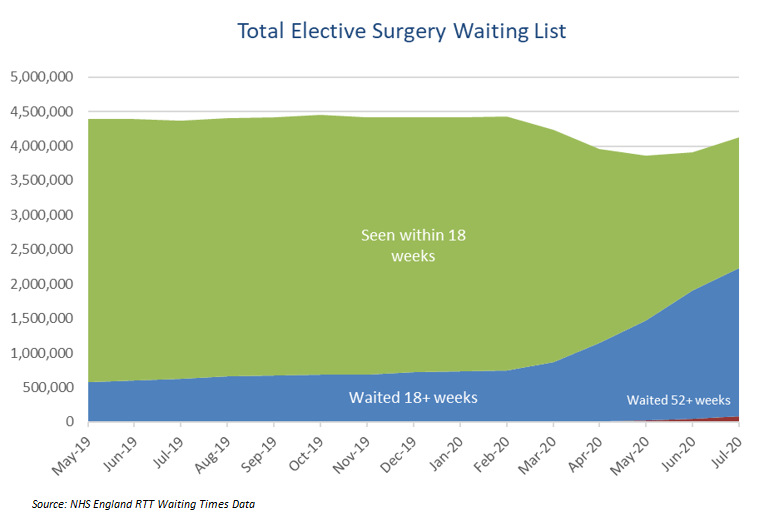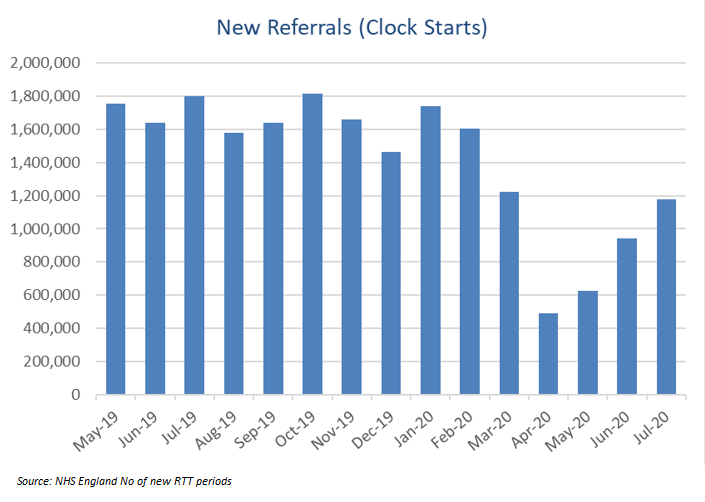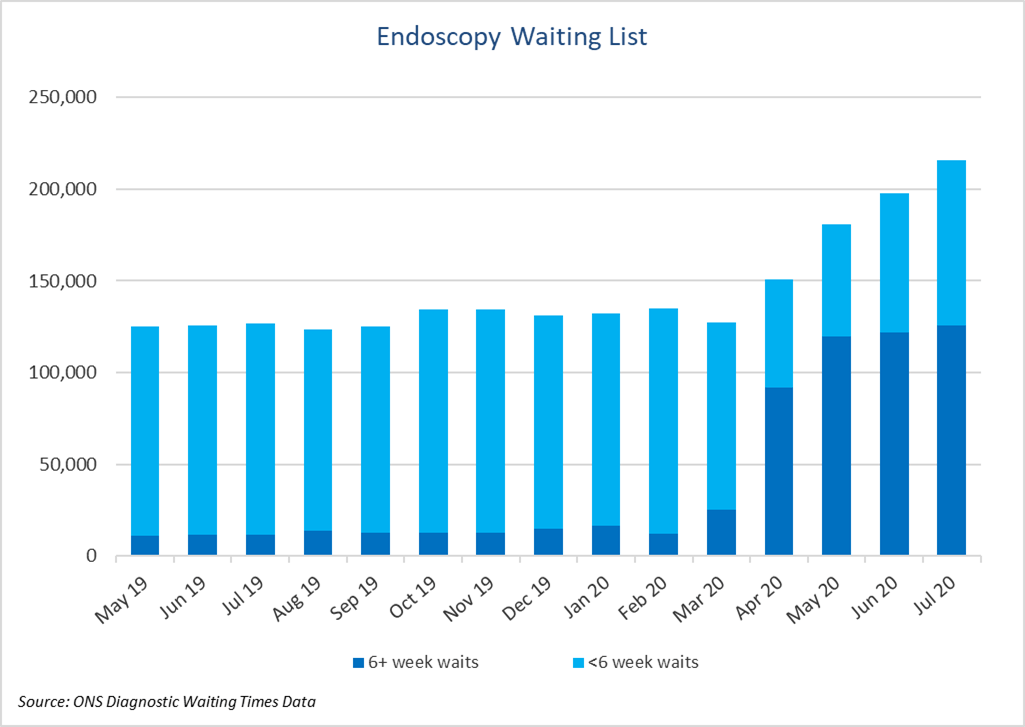Parece que você está nos Estados Unidos
Temos um site diferente (www.q-bital.com) que melhor se adapta à sua localização
À medida que os tempos de espera continuam a aumentar para cirurgias electivas e procedimentos de diagnóstico, o que pode ser feito para resolver o atraso?
Os últimos números divulgados pelo NHS England, que abrangem o período até julho de 2020, mostram que os tempos de espera continuaram a aumentar rapidamente, apesar do número de novas referências permanecer baixo e dos níveis de atividade aumentarem.
Como ilustra o gráfico, o número total de pessoas em lista de espera caiu temporariamente em Março e Abril, principalmente devido a um declínio nas referências, mas está agora a crescer lenta mas continuamente. Mais importante ainda, o tempo que os pacientes aguardam pelo tratamento aumentou substancialmente.
 Em julho, o número de pessoas que estavam em listas de espera há mais de 18 semanas foi o mais elevado desde o início dos registos, com 2,15 milhões. Isto significa que mais de metade das pessoas que aguardam tratamento – 53% – aguardaram mais de 18 semanas pelo tratamento. Antes da pandemia, esta percentagem rondava os 13-14% do total num mês “normal”.
Em julho, o número de pessoas que estavam em listas de espera há mais de 18 semanas foi o mais elevado desde o início dos registos, com 2,15 milhões. Isto significa que mais de metade das pessoas que aguardam tratamento – 53% – aguardaram mais de 18 semanas pelo tratamento. Antes da pandemia, esta percentagem rondava os 13-14% do total num mês “normal”.
Além disso, mais de 83.000 pacientes esperaram mais de um ano pelo tratamento até Julho de 2020. Este foi um aumento substancial em comparação com o ano anterior e representou o maior número de empregados de mesa de 52 semanas vistos desde 2008.
Embora haja alguns pontos positivos nos dados, a saber, que os níveis de atividade em geral e o número de novos encaminhamentos aumentaram, ainda há um longo caminho a percorrer. Em julho, apesar de um aumento significativo, as admissões eletivas estavam em menos da metade do número visto há um ano.
O número de novos encaminhamentos cresceu fortemente desde maio, mas permaneceu bem abaixo dos níveis normais, e parece que os encaminhamentos adiados esperados do período de março a junho ainda não aconteceram.
 Em um recente
artigo no BMJ
Neil Mortensen, presidente do Royal College of Surgeons of England, foi citado dizendo que estava decepcionado ao ver as listas de espera aumentarem em julho, dois meses após o NHS ter publicado um roteiro para restaurar os cuidados de rotina.
Em um recente
artigo no BMJ
Neil Mortensen, presidente do Royal College of Surgeons of England, foi citado dizendo que estava decepcionado ao ver as listas de espera aumentarem em julho, dois meses após o NHS ter publicado um roteiro para restaurar os cuidados de rotina.
Ele disse: “Precisamos urgentemente aumentar nossas reservas hospitalares se quisermos passar por este inverno. A gripe, juntamente com os surtos locais contínuos de covid-19, não deve paralisar as cirurgias novamente, ou milhares de outros sofrerão.” Isso ilustra a gravidade do problema e a falta de resiliência em vastas áreas do setor de saúde do Reino Unido.
Os dados mais recentes de endoscopia contaram uma história semelhante. Mais endoscopias e gastroscopias estavam sendo realizadas, com níveis de atividade mais que dobrando em junho e aumentando em mais 45% em julho, mas mesmo assim, a atividade permanece bem abaixo dos níveis normais.
O número total de pessoas esperando por uma endoscopia em julho de 2020 foi de cerca de 216.000 – um aumento de 70% em comparação a julho do ano passado, com o crescimento não mostrando sinais de desaceleração.
 Embora o número de pessoas esperando por mais de 18 semanas tenha se estabilizado entre maio e julho, o nível é anormal, e entre esses pacientes haverá muitos cuja espera continua a ser estendida além de 18 semanas. Em julho, cerca de 126.000 pessoas — mais da metade das que esperavam por uma endoscopia — esperaram mais de 18 semanas, em comparação com cerca de 12.000 há um ano.
Embora o número de pessoas esperando por mais de 18 semanas tenha se estabilizado entre maio e julho, o nível é anormal, e entre esses pacientes haverá muitos cuja espera continua a ser estendida além de 18 semanas. Em julho, cerca de 126.000 pessoas — mais da metade das que esperavam por uma endoscopia — esperaram mais de 18 semanas, em comparação com cerca de 12.000 há um ano.
Esses números são alarmantes, mas não inesperados, e embora seja provável que a atividade tenha aumentado ainda mais durante agosto e setembro, ainda não se sabe se isso fez alguma diferença nos tempos de espera.
Ao mesmo tempo, os números indicam que podemos estar caminhando para uma temporada de outono e inverno desafiadora, e que recuperar o atraso será incrivelmente difícil. A lenta recuperação da lista de espera eletiva fornece uma indicação de quanto tempo pode levar para descobrir a extensão total da demanda adiada do período de bloqueio.
De uma forma ou de outra, a capacidade precisará ser substancialmente aumentada se o NHS quiser ter alguma chance de reduzir os tempos de espera para tratamentos e procedimentos eletivos. Infraestrutura flexível de saúde, como dispositivos móveis e modulares salas de operação e salas de procedimentos podem fornecer uma solução rápida e eficaz para listas de espera crescentes.
O que também está claro é que essa situação continuará por um longo tempo e precisa de mais do que uma solução de curto prazo. Um edifício modular, abrigando uma sala de cirurgia, sala de tratamento ou enfermaria, pode ser construído próximo ao padrão permanente em um prazo muito curto, e também pode ser configurado e finalizado para atender aos requisitos de cada cliente. Tal edifício fornece espaço adicional de luz Covid e segurança extra para os pacientes, oferecendo uma entrada e área de recepção completamente separadas, bem como uma jornada separada do paciente para aquela no hospital principal.



Vanguard Soluções de Saúde
Unit 1144 Regent Court, The Square, Gloucester Business Park, Gloucester, GL3 4AD

Temos um site diferente (www.q-bital.com) que melhor se adapta à sua localização